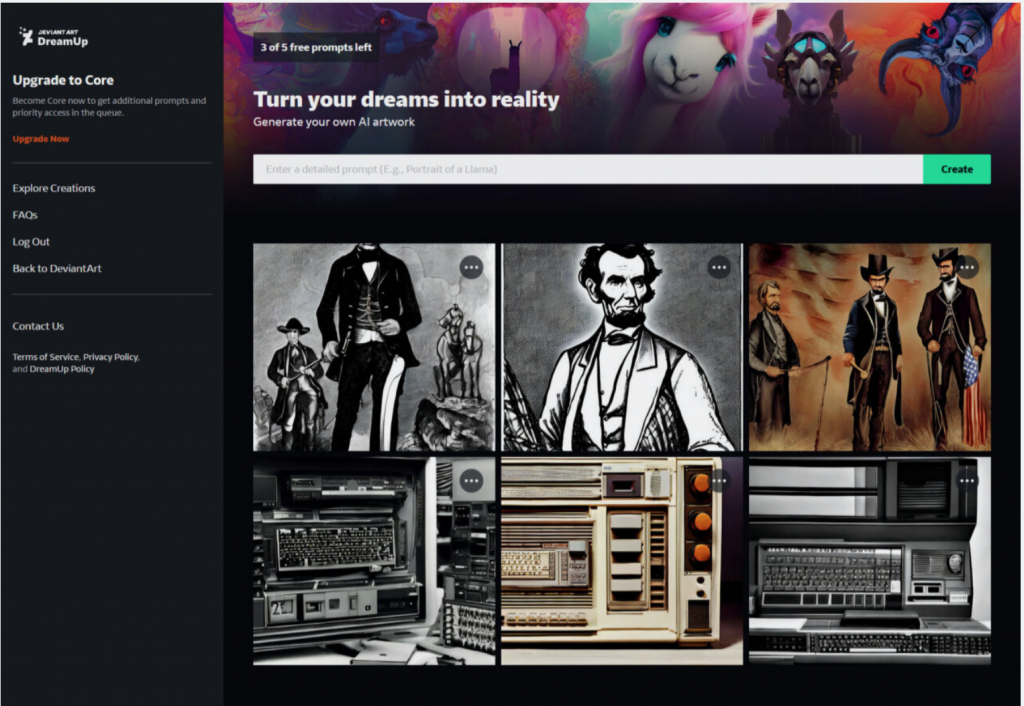
A pair of DreamUp images feature ‘Abraham Lincoln as a cowboy’ and ‘a vintage computer, 35mm photo’ on the website. (Source: Benj Edwards/Artstechnica)
Art Community Objects to Theft of Art by AI-Driven Image Generators
As is often said: “Just when you thought it couldn’t get any weirder.” It can. Or so it appears in a story on arstechnica.com. Author Benj Edwards reported about friction in the art community as a whole, and in the DeviantArt community in particular, on the purported “theft” of art data to use in training image generators. The art collected on the site can be described as fantasy, sci-fi, horror and bizarre in nature.
And that’s not even the weird part yet.
These text-to-image generators are about the hottest AI on the market for the last year. Watching the growth of their ability to create images from a few typed descriptions has been stunning. One artist using a generator even won an art contest in Colorado as was reported in Seeflection recently.
Recently, the online art community DeviantArt announced the debut of DreamUp, an AI-powered text-to-image generator service powered by Stable Diffusion. Simultaneously, DeviantArt launched an initiative that ostensibly lets artists decide whether they wanted to opt out of AI image training, but also accessed online art by default, which angered many members.
DreamUp creates unique AI-generated art based on text prompts. Due to its Stable Diffusion roots, DreamUp learned how to generate images by analyzing hundreds of millions of images scraped off sites like DeviantArt and collected into LAION datasets without artists’ permission, a potential irony that some DeviantArt members found problematic.
Ultimately, DeviantArt announced a change to its AI dataset policy that its hosted images would automatically be labeled that they were not authorized to be used in “AI datasets.” However, AI dataset scrapers would need to agree to this, and they are under no legal obligation to do so—yet. Artists who want to keep their work from being included in DeviantArt’s own AI training for DreamUp will still need to fill out a form.
Unauthorized Web-Scraping
The biggest takeaway from this AI-generated art problem is it seems like it should be easy to solve. If you keep human art in human art shows, and AI-generated art in AI-generated art shows you have no reason to argue.
As far as the third party scraping millions of images to train their algorithms, that is a question of ethics, legal property, and possibly a way for the artists to be paid for their art being used. Do third-party platforms have to agree to this? Nope.
Stable Diffusion’s web-scraping nature ignited a huge debate earlier this year among artists that challenge the ethics of AI-generated artwork. Some art communities have taken hard stances against any AI-generated images, banning them completely.
Perhaps anticipating a backlash, DeviantArt is making overtures to pacify artists who might be upset about their work being used to train AI image generators. The site is providing a special “noai” flag that artists can check in their image settings to opt-out of third-party image datasets. (Whether third-party image scrapers will honor this flag, however, remains to be seen.)
There is a lot more information about new tools, and settings for artists to participate in the projects or not. Some say what is being offered is too little and too late. But if you are interested in this art world kerfuffle take a look at the article at the link below. It is a fun read and it will keep you updated on the most recent digital art tools being operated and thoroughly enjoyed by millions of creative people these days.
read more at arstechnica.com







Leave A Comment